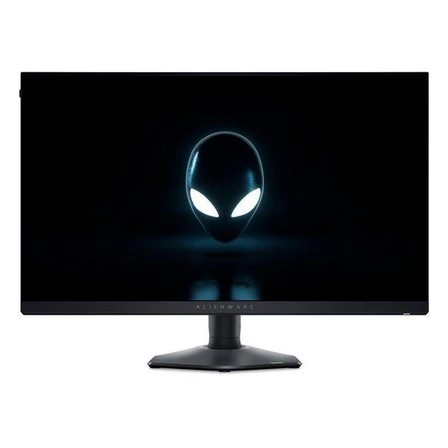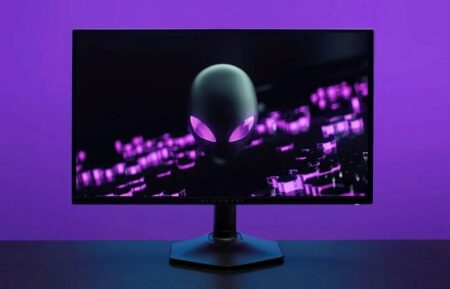CONS
- Only one HDMI port
- Pricey
ALIENWARE AW2725DF 360HZ QD-OLED SPECS
| Panel Size (Corner-to-Corner) |
27 inches |
| Native Resolution |
2560 by 1440 |
| Aspect Ratio |
16:9 |
Alienware’s latest OLED monitor, the AW2725DF 360Hz QD-OLED, may have been overshadowed by the release of the “world’s first” 32-inch 4K OLED gaming monitor, but it is equally impressive in its own right. Despite being smaller and having a lower native resolution, this 27-inch QHD (1440p) monitor stands out with its remarkable 360Hz refresh rate. Similar to other OLED gaming monitors introduced last year, the AW2725DF offers stunning visuals, but its exceptional performance sets it apart. It is this combination of outstanding visuals and top-notch performance that has earned it the prestigious Editors’ Choice award for the best high-end gaming monitor for esports.
Design: Connected and Striking at 27
The 32-inch Alienware that was mentioned earlier made a strong impression on us upon its arrival at PC Labs last month. However, its 27-inch counterpart is equally impressive. Slightly smaller in size, the 27-inch model opts for a flat gaming-monitor design without a curve. Sporting the familiar black bezels that are thin enough to not distract from the picture, along with a hexagonal base that is ideal for gamers to rest their keyboards on during intense combat sessions. In terms of build, it closely resembles the Alienware 500Hz Gaming Monitor (AW2524H), another offering from Dell’s gaming brand that prioritizes peak performance above all else.
The back of the AW2725DF conceals a ventilation layer positioned between the panel and back housing, guaranteeing optimal heat dissipation for the screen. This feature is similar to the one present in the 32-inch model. Additionally, you will notice the illuminated Alienware logo and a prominent “27,” both enhanced with customizable RGB lighting.
The dimensions of the AW2725DF are 15.9 by 23.9 by 9.6 inches (HWD), and it weighs 9.48 pounds without the stand. If you prefer, you can use a VESA mount or your own stand or wall-mount arm. The included stand is quite impressive, as it allows for height adjustment, swivel, pivot, and tilt mobility. When combined with the monitor, the overall size is similar to the LG UltraGear (27GR83Q).

The primary focus of this panel is on performance, however, the AW2725DF offers a wide range of connectivity options. These include an HDMI 2.1 connector, three USB-A ports, a USB-B jack, and a USB-C port. Additionally, there are not just one, but two DisplayPorts available. It is important to note that in order to fully utilize the monitor’s performance capabilities, attention must be paid to the connections used. When connected via DisplayPort, you can achieve a refresh rate of 360Hz at a resolution of 2,560 by 1,440 pixels. On the other hand, when connected via HDMI, the refresh rate is limited to 240Hz, but the same resolution can still be reached.
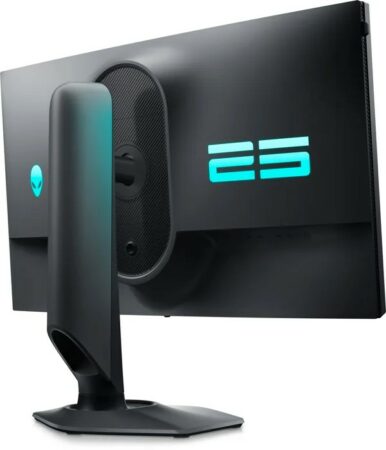
OLED technology is a relatively recent advancement in panel technology. Just a few years back, an OLED panel with such a high refresh rate would have likely been unmatched by any other technology in the market. OLED surpasses IPS, VA, and TN panels in various aspects, ranging from power efficiency to color-gamut support. OLED monitors are capable of showcasing “true” blacks, where black pixels are turned off to produce areas of zero-light and maximum contrast. Given that OLED monitors are now on par with in-plane switching (IPS) panels, which are the standard choice for gaming monitors, they are rapidly becoming the preferred option for gamers seeking a top-tier display.
In contrast to Alienware’s 32-inch OLED, the 27-inch variant lacks Dolby Vision HDR support. However, it still maintains VESA AdaptiveSync certification and offers both AMD FreeSync Premium Pro and Nvidia G-Sync Compatible support, ensuring a seamless gaming experience without screen tearing. Additionally, this monitor boasts several handy features, including a Panel Health screen that can be accessed through the OSD menu operated by the control stick. This screen provides information on whether your panel requires a pixel refresh, which is a preventive measure to prevent individual pixels from deteriorating after prolonged display of the same content (such as onscreen menus or chyrons). This is particularly important for OLEDs as it helps prevent burn-in.
Testing the Alienware AW2725DF: Helping You Win (and Looking Good Doing It)
The AW2725DF 360Hz QD-OLED, similar to the Alienware AW3225QF 4K QD-OLED, is a remarkable display. However, is it significantly superior to other OLED monitors on the market? To assess the disparities and resemblances, we conducted a comprehensive analysis using Calman monitor calibration software, a Murideo Six-G signal generator, and a Klein K-10A colorimeter. Our evaluation encompassed color gamut, brightness, color accuracy, and contrast ratio. Additionally, we subjected the monitor to an array of games to evaluate input lag and determine its real-world performance.
Initially, the monitor was assessed in its factory picture setting using an SDR signal. In this scenario, it displayed an average brightness of 246 nits (candelas per square meter). This falls within the range of its 32-inch counterpart at 238 nits, although it is not as bright as the Corsair Xeneon 27QHD240 OLED’s 307 nits.
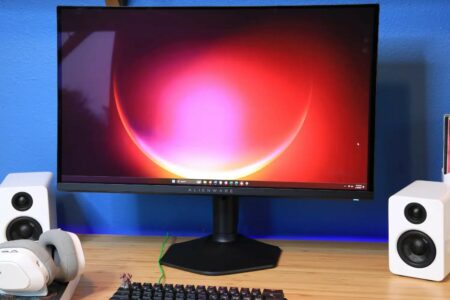
If you are new to OLED technology, you may be accustomed to higher maximum brightness figures typically seen in IPS panels, which can often exceed 500 nits. As a result, you might have concerns about the 246-nit measurement. Nevertheless, OLED screens are capable of preserving contrast at lower brightness levels, ensuring that the picture remains vivid in dimly lit environments such as gaming dens, despite the seemingly lower measured brightness.
When transitioning to HDR mode, we recorded a brightness level of 438 nits by utilizing the Standard preset profile and enabling the HDR Peak 1000 setting. This measurement slightly exceeds the VESA DisplayHDR True Black 400 certification of the monitor.
In addition, Alienware boasts a certified peak brightness of 1,000 nits in HDR, a statement that was verified during our testing. We were able to measure a peak brightness of 1,074 nits with a 2% sample size. It is worth noting that while we typically measure sustained HDR brightness using a 10% window size, we reduce the test size to 2% when measuring peak brightness. This adjustment is necessary because OLED displays tend to become brighter as the test patch size decreases. However, it is important to mention that only a few scenes in video games and movies actually feature highlights that reach this peak measurement.
The transition from brightness to color-gamut performance reveals the OLED panel’s remarkable capabilities. It covered 100% of the sRGB color gamut, 97% of Adobe RGB, and 97% of DCI-P3 in our evaluations. These results are on par with the outstanding ratings of the Alienware AW3225QF 4K QD-OLED and are also comparable to Samsung’s Odyssey OLED G9. Thus far, we have not encountered an OLED display that disappoints in terms of color coverage or performance in this aspect.
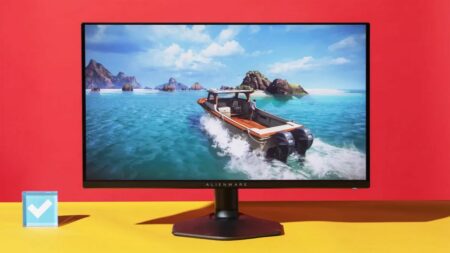
The monitor achieved an outstanding Delta E measurement of 0.5, showcasing impressive color accuracy. A Delta E value below 1 is considered ideal, indicating minimal deviation from the intended hue. It is rare for gaming monitors to achieve such precision, particularly without any calibration.
Our ultimate examination evaluates the contrast ratio, which signifies the variance in brightness between the brightest white and the darkest black that a monitor can display. This factor significantly impacts the quality of images, particularly in dimly lit scenes in video games. The AW2725DF boasts a peak contrast ratio of 1,000,000:1, although this figure is unlikely to be observed in everyday usage. (During our formal assessment, we recorded a contrast ratio of 234,046:1, which likely pushes the boundaries of our equipment and testing software.) OLED and mini LED panels have the potential to achieve significantly higher contrast ratios compared to other panel technologies, primarily due to the characteristics of black pixels. Conversely, IPS panels typically aim for contrast ratios ranging from 1,000:1 to 3,000:1.
Game and Media Performance
The AW2725DF offers more than just stunning visuals typical of an OLED display. If you prioritize game performance alongside visuals and are considering a monitor with a 360Hz refresh rate, this model is worth considering. To assess input lag, we utilize an HDFury Diva HDMI matrix and test various games from our collection to identify any potential issues such as screen tearing.
The AW2725DF exhibited an input lag of less than 1 millisecond (ms) when tested with the HDFury at default settings. Our measurement of input lag is limited to 240Hz due to the inability to measure input lag over a DisplayPort connection using the HDFury matrix. Additionally, the HDMI connections on this panel are restricted to a maximum refresh rate of 240Hz. For refresh rates higher than 240Hz, we have to rely on anecdotal in-game testing.]
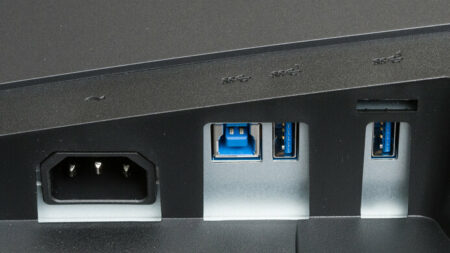
With a response time of under 1ms, you can anticipate seamless performance while engaging in a wide range of gaming genres, including first-person shooters and action games. The remarkable refresh rate of the Alienware monitor is sure to captivate esports enthusiasts and dedicated gamers who seek elevated refresh rates coupled with superior resolutions. For those who prioritize competitive gaming, the Alienware 500Hz Gaming Monitor (AW2524H) is worth considering, despite the trade-offs in terms of size, resolution, and the absence of an OLED panel, all in pursuit of the utmost refresh rate achievable.
The AW2725DF excels whether you are fully immersed in intense gaming sessions or simply enjoying some casual play. Cyberpunk 2077: Phantom Liberty, Returnal, and Baldur’s Gate 3 showcase exceptional clarity on the OLED monitor. In terms of multiplayer gaming, Counter-Strike 2 and Fortnite perform smoothly at high refresh rates, with no visible screen tearing.
And all of this is available for less than which is a delightful surprise, although still relatively costly for a 27-inch panel. The Corsair Xeneon 27QHD240 OLED, the most similar OLED monitor we have tested, is. Does this indicate that OLED monitors are gradually becoming more affordable? While a $100 difference suggests there is still a significant gap to bridge, with the increasing prevalence of monitors like these, we may witness further reductions in.
The Alienware AW2725DF is equally remarkable as its 4K counterpart, catering to a slightly distinct audience. Enthusiastic gamers and esports enthusiasts will value its elevated refresh rates, while the QHD resolution combined with the OLED display provides a visually stunning experience regardless of the game or movie. Although there are monitors with even higher refresh rates, only a few can achieve the same level of performance and visual harmony as the Alienware AW2725DF, making it deserving of our esteemed Editors’ Choice accolade.

